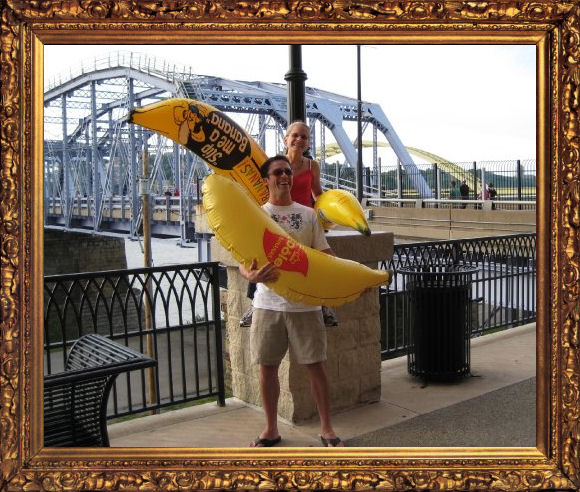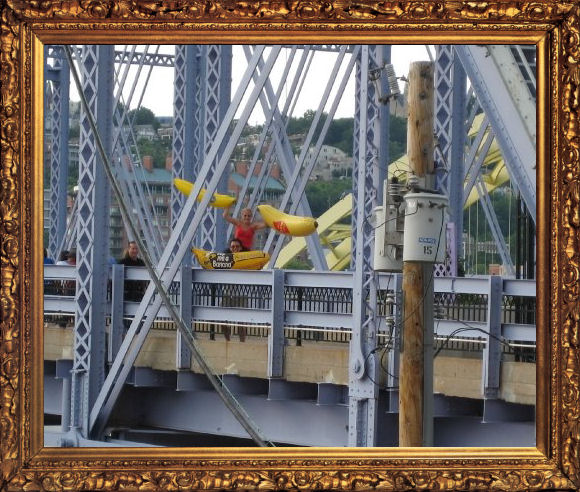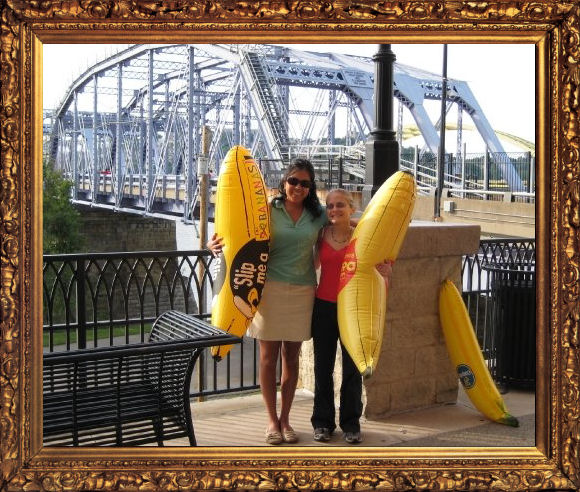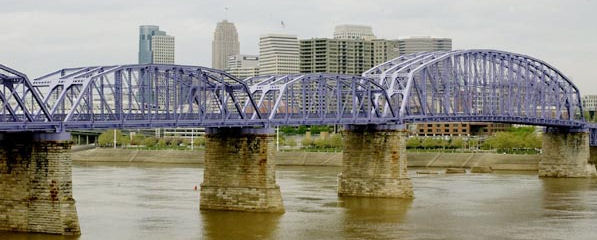
Matt Bean & Julie Bartholomew
The Purple People Bridge
Cincinnati, Ohio
2009

Matt Bean & Julie Bartholomew
The Purple People Bridge
Cincinnati, Ohio
2009

Erica Boyaneto & Julie Bartholomew
The Purple People Bridge
Cincinnati, Ohio
2009



There are many articles and pictures on the Web about Cincinnati's "Purple People Bridge." The following was combined, adapted and condensed from two different articles originally appearing in the Cincinnati Enquirer on April 20, 2003.
One-of-a-kind crossing to open Saturday
By Patrick Crowley

Newport Southbank Bridge, the "Purple People Bridge," connects Pete Rose Way
in Cincinnati to Third Street in Newport, Kentucky. Photo by Ernest Coleman.
NEWPORT - Of the nine bridges crossing the Ohio River at Cincinnati, only one is purple. Starting Saturday, it will be the only one just for people, too.
After a $4 million restoration, the former L&N Railroad Bridge between Newport and Cincinnati will reopen as a pedestrian walkway. Officially named the Newport Southbank Bridge, the “Purple People Bridge” will be the longest connector of its kind in the country that links two states.
“Everybody has already been calling it the Purple People Bridge,” says Wally Pagan, president of Newport-based Southbank Partners, a non-profit group promoting economic development in Northern Kentucky’s river cities. “Because of the color, it’s a name that is going to stick.”
The bridge—it’s 2,670 feet, or just over a half a mile long—has been redesigned to provide an easy way for people to move between the two states. It also could link the riverfronts of Ohio and Kentucky in a seamless collection of entertainment, dining, nightlife, festivals, parks, attractions and more that could bring hundreds of thousands to the river’s edge.
The Purple People Bridge marks the first time in Greater Cincinnati’s modern history that a span is dedicated exclusively to pedestrian traffic. It will bring two of the Tristate’s most important entities—downtown Cincinnati and Northern Kentucky’s river cities—even closer together, officials say. “It’s a very exciting and unique way to cross the river more freely and easily and it helps everybody by bringing people to the entertainment, parks and other attractions and areas on both sides of the river,” says David Pepper, a Cincinnati City councilman.
At 17 feet wide, the bridge probably isn’t wide enough to host festivals and other events. But the approaches on both sides of the river can host events, festivals and private gatherings, Pagan says. Developers say they have transformed a rickety structure that hasn’t been used by trains, vehicles or people since 2001 into a new community icon. They want the bridge to be used by strolling romantics, energetic skaters, fun-seeking families and suburbanites wanting to establish ties to the muddy Ohio River.
So why purple? Southbank Partners, the nonprofit group that is the primary developer of the Newport Southbank Bridge, convened focus groups during the planning for converting the span to a pedestrian walkway over the Ohio River. More than a dozen groups were shown computer-generated images of how the bridge would look painted a variety of colors, including dark purple, green, rust, orange and white. In every group, purple and green were among the top choices.
Ted Bushelman is a Southbank volunteer and longtime director of communications at the Cincinnati/Northern Kentucky International Airport. His master’s thesis at Xavier University was entitled “The Psychology of Color.” Bushelman says “Seeing is as much in the brain as it is in the eye. I redid some of my research and gave the information to Southbank. Purple is a good color for public consumption. If you paint a room purple, it can drive you crazy. But it looks good on something like a bridge.”